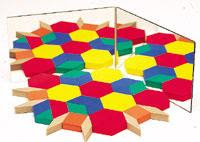
Sometimes (especially in these tricky economic times) adapting a well-designed "off the shelf" item to an exhibit purpose can be a real budget saver. Whether to provide an additional tabletop interactive in a larger exhibition, or as a collection of simple, portable exhibits for outreach, I've found the items listed below to provide good foundations for simple open-ended exhibit components.
Each idea below is followed by a short example set-up description and relevant web link(s). All the materials (including laminated graphics/labels) can easily fit into standard-sized plastic storage bins with resealable lids.
1) Mini-microscope
These hand-held microscopes are great! They are battery operated (buy rechargeable!) and can be used with flat(ish) materials like fabrics, papers, etc. Also you can make your own “slides” with a business card sized laminator.

2) CITIBLOCS
Just put out a batch of CITIBLOCS on a flat surface and stand back! People of all ages love them. There are also Kapla Books and cards that have nice images of block projects to get people started.
3) Mirrors/Symmetry
Make, or buy from ETA, small rectangles of plexi mirror (with rounded corners!)
Then use Duncan Birmingham’s books, like M is for Mirror, as references to create your own laminated symmetry activity sheets.
Lastly, Pattern Blocks (also from ETA) make a great exhibit with two fixed plexi mirrors at 90 degrees to each other.

4) Geoboards
Buy a set of 10 WOODEN geoboards, but only put out three or four at a time. Include some colored rubber bands and watch the cool artistic AND mathematical patterns kids make!
5) Magna-Tiles
Use the translucent Magna-Tiles to allow visitors to create both 2-D and 3-D patterns that are like playing with stained glass. If you can throw a light table, or back-lit piec e of milky acrylic into the mix (as in the picture below) so much the better!

6) Moiré
Use “found objects” such as strainers, perforated metal, window screen, to create a Moiré Discovery Kit. You can also laminate downloadable moiré patterns here.
7) "Bill Ding" Acrobat Blocks
Buy a set or two of "Bill Ding" acrobatic blocks for visitors to use. The clever design of these blocks allows folks to not only explore pattern making, but physical principles related to balance, gravity and symmetry as well.

8) 3-D Images
Get several sets of “Proview” 3-D Glasses from the Rainbow Symphony Company. Then laminate 3-D images of your own choosing. NASA has free images you can download of Earth, Mars and the Sun , for example.
See the NASA links and other 3-D resources at this page on Rainbow Symphony’s site.
9) Tuning Forks Station
NASCO sells nice tuning forks and accessories. Buy a variety, but just put out three or four different sizes at a time. You will also want to get a large “rubber pad” or large rubber “activator” for kids to strike the forks on to get them to vibrate. (The idea is not to strike the tuning forks on themselves or other hard objects!)
Other props for this station include a shallow round Tupperware container filled with water to create sound “waves”. Also, a suspended strip of Mylar or Tyvek paper can show the air being moved by tuning fork vibrations.
10) Mazes/Marble Runs
Buy a nice selection of Cuboro wooden marble runs.
Big fun! And great three-dimensional thinking/planning skills.
What "off the shelf" exhibit solutions or resources have you found? Let us know in the "Comments" section below!
Don't miss out on any ExhibiTricks posts! It's easy to get updates via email or your favorite news reader. Just click the "Free Updates" link on the right side of the blog.
P.S. If you receive ExhibiTricks via email (or facebook or LinkedIn) you will need to click HERE to go to the main ExhibiTricks page to make comments or view multimedia features (like videos!)









